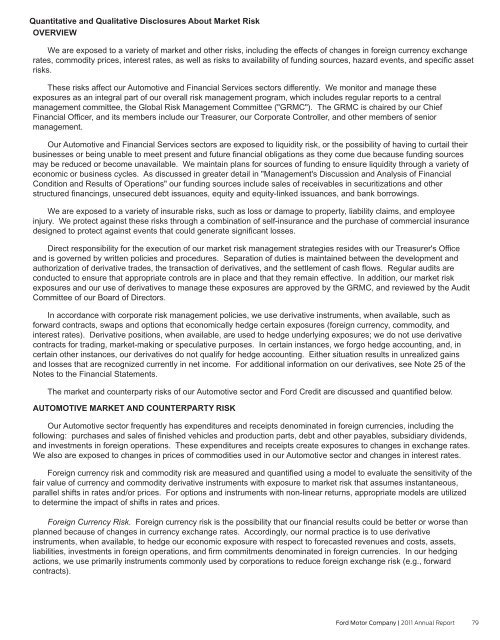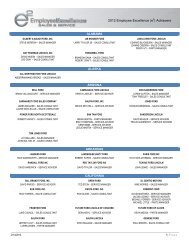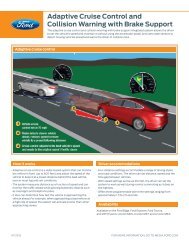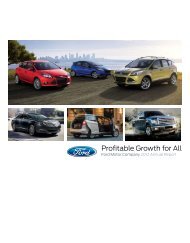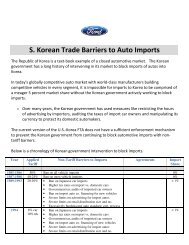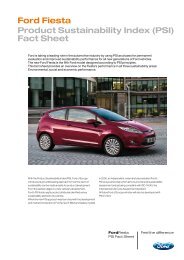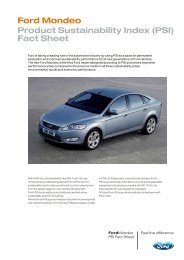Annual Report 2011 - Ford Motor Company
Annual Report 2011 - Ford Motor Company
Annual Report 2011 - Ford Motor Company
You also want an ePaper? Increase the reach of your titles
YUMPU automatically turns print PDFs into web optimized ePapers that Google loves.
Quantitative and Qualitative Disclosures About Market Risk<br />
OVERVIEW<br />
We are exposed to a variety of market and other risks, including the effects of changes in foreign currency exchange<br />
rates, commodity prices, interest rates, as well as risks to availability of funding sources, hazard events, and specific asset<br />
risks.<br />
These risks affect our Automotive and Financial Services sectors differently. We monitor and manage these<br />
exposures as an integral part of our overall risk management program, which includes regular reports to a central<br />
management committee, the Global Risk Management Committee ("GRMC"). The GRMC is chaired by our Chief<br />
Financial Officer, and its members include our Treasurer, our Corporate Controller, and other members of senior<br />
management.<br />
Our Automotive and Financial Services sectors are exposed to liquidity risk, or the possibility of having to curtail their<br />
businesses or being unable to meet present and future financial obligations as they come due because funding sources<br />
may be reduced or become unavailable. We maintain plans for sources of funding to ensure liquidity through a variety of<br />
economic or business cycles. As discussed in greater detail in "Management's Discussion and Analysis of Financial<br />
Condition and Results of Operations" our funding sources include sales of receivables in securitizations and other<br />
structured financings, unsecured debt issuances, equity and equity-linked issuances, and bank borrowings.<br />
We are exposed to a variety of insurable risks, such as loss or damage to property, liability claims, and employee<br />
injury. We protect against these risks through a combination of self-insurance and the purchase of commercial insurance<br />
designed to protect against events that could generate significant losses.<br />
Direct responsibility for the execution of our market risk management strategies resides with our Treasurer's Office<br />
and is governed by written policies and procedures. Separation of duties is maintained between the development and<br />
authorization of derivative trades, the transaction of derivatives, and the settlement of cash flows. Regular audits are<br />
conducted to ensure that appropriate controls are in place and that they remain effective. In addition, our market risk<br />
exposures and our use of derivatives to manage these exposures are approved by the GRMC, and reviewed by the Audit<br />
Committee of our Board of Directors.<br />
In accordance with corporate risk management policies, we use derivative instruments, when available, such as<br />
forward contracts, swaps and options that economically hedge certain exposures (foreign currency, commodity, and<br />
interest rates). Derivative positions, when available, are used to hedge underlying exposures; we do not use derivative<br />
contracts for trading, market-making or speculative purposes. In certain instances, we forgo hedge accounting, and, in<br />
certain other instances, our derivatives do not qualify for hedge accounting. Either situation results in unrealized gains<br />
and losses that are recognized currently in net income. For additional information on our derivatives, see Note 25 of the<br />
Notes to the Financial Statements.<br />
The market and counterparty risks of our Automotive sector and <strong>Ford</strong> Credit are discussed and quantified below.<br />
AUTOMOTIVE MARKET AND COUNTERPARTY RISK<br />
Our Automotive sector frequently has expenditures and receipts denominated in foreign currencies, including the<br />
following: purchases and sales of finished vehicles and production parts, debt and other payables, subsidiary dividends,<br />
and investments in foreign operations. These expenditures and receipts create exposures to changes in exchange rates.<br />
We also are exposed to changes in prices of commodities used in our Automotive sector and changes in interest rates.<br />
Foreign currency risk and commodity risk are measured and quantified using a model to evaluate the sensitivity of the<br />
fair value of currency and commodity derivative instruments with exposure to market risk that assumes instantaneous,<br />
parallel shifts in rates and/or prices. For options and instruments with non-linear returns, appropriate models are utilized<br />
to determine the impact of shifts in rates and prices.<br />
Foreign Currency Risk. Foreign currency risk is the possibility that our financial results could be better or worse than<br />
planned because of changes in currency exchange rates. Accordingly, our normal practice is to use derivative<br />
instruments, when available, to hedge our economic exposure with respect to forecasted revenues and costs, assets,<br />
liabilities, investments in foreign operations, and firm commitments denominated in foreign currencies. In our hedging<br />
actions, we use primarily instruments commonly used by corporations to reduce foreign exchange risk (e.g., forward<br />
contracts).<br />
<strong>Ford</strong> <strong>Motor</strong> <strong>Company</strong> | <strong>2011</strong> <strong>Annual</strong> <strong>Report</strong> 79


